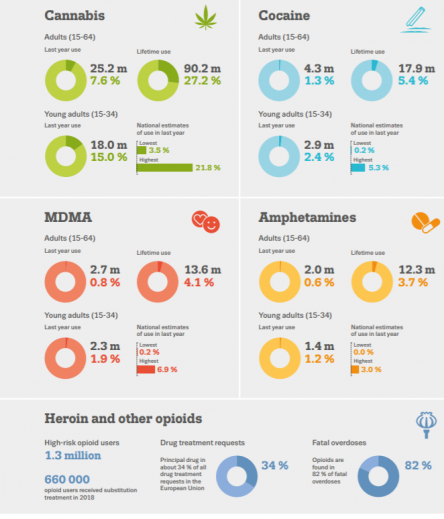The European Drug Report 2020: Trends and Developments is out! This publication of the European Monitoring Centre for Drugs and Drug Addiction (EMCDDA) can be found here, but we would like to highlight some key issues:
Large drug shipments are increasingly intercepted, suggesting that organised crime groups are infiltrated in logistical supply chains, shipping routes and large ports.
The number and quantity of cocaine seizures are now the highest ever reported (181 tonnes seized in 2018). Belgium, Spain and the Netherlands are key countries for the interception or large quantities. Also, small but increasing seizures of coca leaves and coca paste indicate the use of laboratories manufacturing cocaine from coca leaves or paste.
Indicators of heroin use continue to suggest an ageing cohort of users with low rates of initiation. Also, new drug treatment entries associated with heroin have also fallen in many countries. However, a doubling of the volumes of heroin seized (28.3 tonnes in 56,000 seizures) and increasing volumes seized in Turkey suggest that heroin manufacturing is taking place within the EU. This is corroborated by the seizure of almost 16 tonnes of the heroin precursor chemical acetic anhydride in 2018 in the EU and the supply of a further 9 tonnes that was stopped before it entered the supply chain. Moreover, laboratories producing heroin from morphine in Bulgaria, Czechia, Spain and the Netherlands have discovered in recent years, and seizures of morphine and opium have increased.
Cannabis market is changing, with the presence of high-THC (tetrahydrocannabinol) content products, and new forms of cannabis and commercial products based on extracts from the cannabis plant becoming increasingly available. There were 3.3 million cannabis plants seized in the EU in 2018, an indicator of the production of the drug within a country.
The total quantities of precursors and alternative chemicals used for the production of amphetamine seized in 2018 in the EU reached an all-time high at 73 tonnes. Methamphetamine seized in Europe is mainly produced in Czechia, from pseudoephedrine extracted from medicinal products, and the border areas of neighbouring countries.
23 active MDMA laboratories were reported to have been dismantled in the EU in 2018, with most (20) detected in the Netherlands. The discovery of 2 MDMA laboratories in Spain and 1 in Sweden suggests a diversification of production locations. The seized quantities of the MDMA precursor PMK (piperonyl methyl ketone) and non-scheduled chemicals for MDMA manufacture have decreased from 26 tonnes in 2017 to under 16 tonnes in 2018. However, innovation and scaling-up of synthetic drug production in Europe is evident in the continued availability of high-content MDMA tablets and high-purity powders.
Established and new drugs continue to be produced in Europe, for local and global markets, with more laboratories and production sites detected by law enforcement. The production of illicit drugs is now based on a more diverse set of chemicals, which are both difficult to respond to under European and international laws and challenging to monitor. In 2018, a total of 50 kilograms of the cathinone precursor 2-bromo-4-methylpropiophenone was seized within the EU, while 3 laboratories producing mephedrone were detected in Spain, the Netherlands and Poland, indicating the continued production of this drug within Europe. In 2018 more than half a kilogram of 4-anilino-N-phenethylpiperidine (ANPP) was seized in France and a shipment of 3 kilograms of N-phenetyl-4-piperidone (NPP) was stopped in Belgium. Both are precursors for the manufacture of fentanyl and fentanyl derivatives.
Both uncontrolled and less common substances may constitute a growing problem, as indicated for example by the increased quantities seized of ketamine, GHB (gamma-hydroxybutyrate) and LSD (lysergic acid diethylamide). In addition, concerns have been raised by some countries about the use of substances such as N2O (nitrous oxide). Non-controlled and new benzodiazepines are also a growing concern.
More than 50 new psychoactive substances continue to be detected for the first time annually by the EU Early Warning System. Alongside this, each year about 400 previously reported new psychoactive substances are detected on the European market. These substances, which include stimulants, synthetic cannabinoids, benzodiazepines, opioids, hallucinogens and dissociatives, are drawn from a broad range of drug types and are not controlled by international drug laws.


